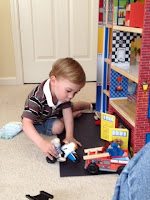Sunday, August 5, 2012
Doll House vs. Fire Station
In this post I’m going to be bringing together a number of different themes (and not signing with babies, for a change) that are salient in research on early child development: Sex differences in choice of toys; the fact that girls learn to talk on average earlier than boys, and the relationship between different types of play and language development. And I’m going to do all this by highlighting a a photo I took last week while taking care of my twin grandchildren, Nate and Olivia.
• First, sex differences in choice of toys: From the time they were old enough to make choices for themselves, it’s been clear (despite efforts from parents and grandparents to the contrary) that Nate was in love with anything with wheels and vroom-vroom noises and Olivia with anything pink, purple, and with the word “princess” or “baby” in the title. In fact, one of the most recent of Olivia’s favorites is a large pink and white plastic doll house complete with pink and white frilly furniture and a pink clad baby. Needless to say, Nate is not equally enchanted.
• Second, sex differences in verbal development: One of the most robust of all differences between boys and girls is the fact that—on average—girls learn to talk earlier than boys. (Note. This is true for learning words, but not signs. No sex difference there.)
• Third, relationship between types of play and verbal development: Dr. Susan Goodwyn and I discovered a number of years ago that pretend play, in contrast to manipulative play (where the child just moves pieces in some way—like shape sorters, hammers and peg boards, puzzles), helps facilitate language development. There are a number of reasons why, but the main one is because pretend play involves so much language itself! The child is thinking and often explaining out loud pieces of some kind of simple plot, either alone or in response to questions from adults. Susan and I suspect that one of the reasons boys lag behind girls in language is because the toys they are typically given (with some exceptions to be sure) are less likely to inspire pretending than the baby dolls, tea sets, and doll houses typically given girls.
So, how do these three observations relate to the photo above? Take a close look at the nature of the toy Nate is playing with. It is, in fact, a miniature structure. But instead of being a typical “doll house” like Olivia’s, it’s a pretend fire station. It has many of the same things Olivia’s does--a kitchen (firefighters have to eat after all), bathroom, bedroom and living area—but it also has a pole to slide down, a treadmill, an elevator, a fire truck, and a heliport! My point is that it has characteristics that Nate, like lots of little boys, value while at the same time promoting the type of play (i.e., pretending) that is so good for language development. And he loves it! I stood and watched him play for a long time and was amazed at the imaginary scenarios he was describing in words, both to himself and in explanation to me.
The lesson in all this is directed at parents and grandparents as they think about appropriate toys. Simply, keep in mind that pretending is critical to both boys and girls and that sex difference in preferences for pretend scenarios are often a fact of life, but that with a bit of creative thinking on our own parts, it’s possible to satisfy both requirements.
Happy Signing (and don’t forget to visit us on Facebook)!
Linda
Linda Acredolo, Ph.D.
Professor Emeritus, UC Davis
and
Co-Founder, The Baby Signs® Program
Thursday, December 30, 2010
Make Room for Dolls!

A few days ago I wrote about the “Truck” gene and how my 18-month-old grandson was totally “gaga” over trucks. Well, that’s still true, but there’s another side to the story that pleases me no end.
Before Christmas my daughter-in-law, Julie, decided to give Olivia, Nate’s twin sister, a baby stroller and baby doll. The more she thought about it, however, the more concerned she became over not doing the same for Nate. Her motivation was partly philosophical (not wanting to perpetuate gender stereotypes) and partly practical ( knowing how Nate and Olivia, fight over toys). Because of these concerns, and despite feeling a bit extravagant, she purchased an identical stroller and similar baby doll for Nate.
Turns out it was a good thing that she did. Although his two Christmas trucks still hold a special place in his heart, he is also enthusiastically tooling around the house with a baby doll (any will do) in his stroller! Not only that, but he was the first of the two children to put a doll to bed in the wooden toy cradle that my husband and I made for them and rock the cradle back and forth! Actually, it shouldn’t come as a complete surprise because the twins witness their dad, Jim, doing these kinds of things every single day with a smile on his face and obvious joy in his heart.
What lessons do I take from this? Here’s the first: Yes, both girls and boys may have a hierarchy for play, placing one type of toy at the very top (trucks for Nathan), but that doesn’t mean that they don’t also get pleasure out of others. Like adults, children are not one-dimensional. The second lesson is even more important: Especially if they see the males they love modeling such behavior, little boys who love trucks can also love nurturing children and see it as a natural activity than any girl or boy can truly enjoy.
Happy New Year!
Linda
Linda Acredolo, Ph.D.
Co-Founder, the Baby Signs Program
and
Professor Emeritus, UC Davis

